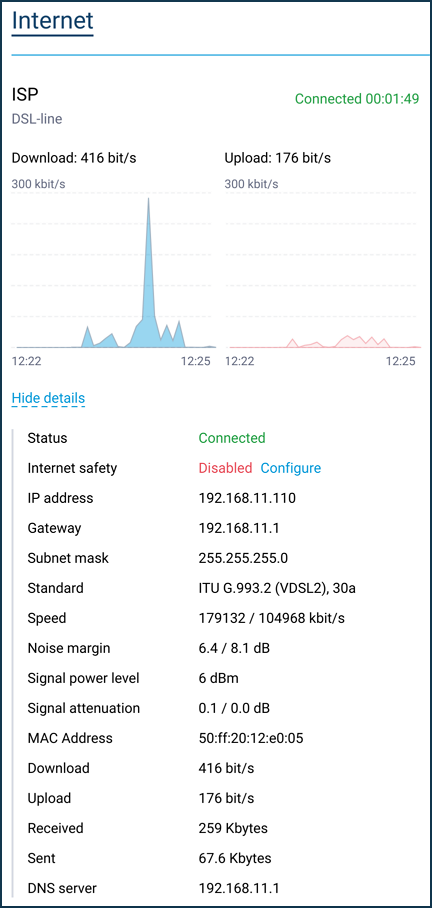VDSL line parameters
In the web interface of Keenetic Ultra SE (KN-2510) on the System dashboard page in the 'Internet' information panel, you can see the status of the VDSL connection, its current parameters, and perform the initial diagnostics. To display additional connection information, click 'More details'.

The main technical characteristics of the established VDSL connection are shown in the parameters 'Standard', 'Speed', 'Noise margin', 'Signal power level', and 'Signal attenuation'. The VDSL2 uses the same parameters as ADSL2+ technology. Below are descriptions of the main parameters and characteristics of the physical communication channel (leased line).
Standard — a VDSL standard, using which the connection to the DSLAM (DSL switch) is established.
Keenetic Ultra SE (KN-2510) supports VDSL standard ITU-T G.993.2 (VDSL2) and profiles 8a, 8b, 8c, 8d, 12a, 12b, 17a, 30a, 35b.
VDSL2 is an extension of the G.993.1 standard (VDSL), which allows asymmetric and symmetric traffic (DS and US) over copper wire pair up to 1.5 km long. The main and only modulation is DMT (Discrete Multi-Tone). The VDSL2 technology uses an operating frequency range of up to 30 MHz. For data reception, the band 12 ~ 18 MHz is used, for transmission — 18 ~ 30 MHz.
The channel rate of VDSL2 depends directly on the distance of the leased line. The maximum available data transfer rate is achieved at distances of up to 300 meters. The speed starts to decrease from a distance of 0.5 km, and on a line length of 1 km or more, you can see a significant drop in rate.
The VDSL2 standard defines a wide range of profiles. Profile comparison table:
Profile | Bandwidth (MHz) | Number of total carriers | Maximum aggregate downstream transmit power (dBm) | Max. downstream throughput (Mbit/s) | Max. upstream throughput (Mbit/s) |
|---|---|---|---|---|---|
8a | 8.832 | 2048 | +17.5 | 50 | 16 |
8b | 8.832 | 2048 | +20.5 | 50 | 16 |
8c | 8.500 | 1972 | +11.5 | 50 | 16 |
8d | 8.832 | 2048 | +14.5 | 50 | 16 |
12a | 12 | 2783 | +14.5 | 68 | 22 |
12b | 12 | 2783 | +14.5 | 68 | 22 |
17a | 17.664 | 4096 | +14.5 | 100 | 50 |
30a | 30.000 | 3479 | +14.5 | 200 | 50 |
35b | 35.328 | 8192 | +17.0 | 300 | 100 |
Speed is the channel rate of the connection to the DSLAM. Two speeds are displayed: the first number is the receiving speed, i.e. the speed to the subscriber (DS / downstream), and the second number is the transmission speed, i.e. from the subscriber (US / upstream).
The maximum theoretically achievable channel rate according to VDSL2 standard is 200 / 100 Mbit/s.
Noise margin is used as a line condition assessment criterion and determines the minimum limit at which the signal level is above the noise level. Noise margin is a good indication of the line quality. The transmission noise margin limit is 6 dB, a value below which a VDSL connection is not guaranteed at all. If the noise margin is below 6 dB, frequent interruptions may occur.
If the noise margin is greater than 10 dB, the line has good parameters for data transmission. The higher the noise margin, the better the line quality. The 'Noise margin' parameter value should be 6 dB or higher. It can reach up to 30 dB if a short line is used.
The 'Noise margin' field displays two values — the first number for the direction to the subscriber (DS) and the second number for the direction from the subscriber (US).
The value of 'Noise margin' [dB]:
up to
6 dB— a low-quality line, there are synchronization problems;7 dBto10 dB— failures may occur;11 dBto20 dB— good line, no synchronization problems;21 dBto28 dB— a very good line;29 dBand above — an excellent line.
When connecting a VDSL modem to a DSLAM, the relationship between the parameters of the noise margin, connection speed and line length is as follows:
at a fixed noise margin, the connection speed decreases with increasing line length, and vice versa;
at a fixed line length, the limit of noise margin decreases with increasing speed, and vice versa;
at a fixed connection speed, the line length must be shortened to increase the noise margin.
Signal power level (Output Power) — shows the output power of the signal as the modem is synchronized with the DSLAM. Typically, the output power when sending data is approximately 10 dBm. This value may be lower due to signal power loss.
Signal attenuation — shows signal attenuation in the line as the modem synchronizes with the DSLAM (this parameter should be less than 45 dB). The attenuation depends on the length of cable between the VDSL modem and DSLAM. The higher the value of this parameter, the lower the line quality and therefore, the lower the transmit/receive rate. Optimal values should be between 5 dB and 30 dB (for excellent and good line). An attenuation value of 45 dB and above means that the line is not suitable for VDSL to use.
The 'Signal attenuation' field displays two values — the first number for the direction to the subscriber (DS) and the second number for the direction from the subscriber (US).
The value of 'Signal attenuation' parameter [dB]:
up to
20 dB— an excellent line;20 dBto40 dB— working line;40 dBto50 dB— failures may occur;50 dBto60 dB— synchronization drops periodically;60 dBand above — the equipment will not work.
If your VDSL connection performance is poor, contact your ISP to resolve the physical link problem.
For more information on the specification of the VDSL2 standard, please go to Wiki.